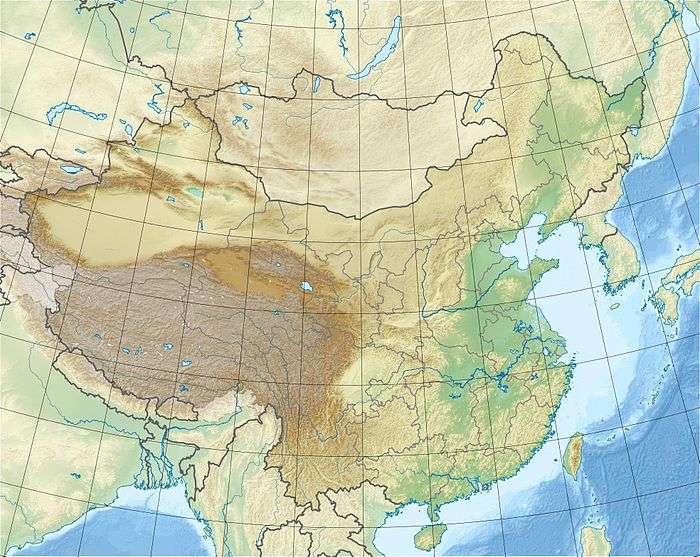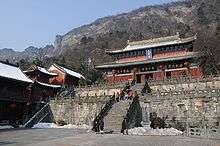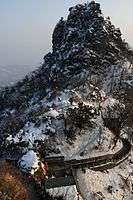Wudang Mountains
The Wudang Mountains (simplified Chinese: 武当山; traditional Chinese: 武當山; pinyin: Wǔdāng Shān) consist of a small mountain range in the northwestern part of Hubei, China, just south of Shiyan. They are home to a famous complex of Taoist temples and monasteries associated with the god Xuanwu. The Wudang Mountains are renowned for the practice of Tai chi and Taoism as the Taoist counterpart to the Shaolin Monastery,[1] which is affiliated with Chinese Chán Buddhism. The Wudang Mountains are one of the "Four Sacred Mountains of Taoism" in China, an important destination for Taoist pilgrimages.
| UNESCO World Heritage Site | |
|---|---|
 | |
| Location | Hubei, China |
| Criteria | Cultural: i, ii, vi |
| Reference | 705 |
| Inscription | 1994 (18th session) |
| Coordinates | 32°24′03″N 111°00′14″E |
 Location of Wudang Mountains in China | |
| Wudang Mountains | |||||||||||||||||||||||
|---|---|---|---|---|---|---|---|---|---|---|---|---|---|---|---|---|---|---|---|---|---|---|---|
.svg.png) "Wudang Mountains" in Simplified (top) and Traditional (bottom) Chinese | |||||||||||||||||||||||
| Traditional Chinese | 武當山 | ||||||||||||||||||||||
| Simplified Chinese | 武当山 | ||||||||||||||||||||||
| |||||||||||||||||||||||
Geography
On Chinese maps, the name "Wudangshan" (Chinese: 武当山) is applied both to the entire mountain range (which runs east-west along the southern edge of the Han River, crossing several county-level divisions of Shiyan), and to the small group of peaks located within Wudangshan subdistrict of Danjiangkou, Shiyan. It is the latter specific area which is known as a Taoist center.[2]
Modern maps show the elevation of the highest of the peaks in the Wudang Shan "proper" as 1612 meters;[2][3] however, the entire Wudangshan range has somewhat higher elevations elsewhere.[2]
Some consider the Wudang Mountains to be a "branch" of the Daba Mountains range,[3] which is a major mountain system in western Hubei, Shaanxi, Chongqing and Sichuan.
History
For centuries, the mountains of Wudang have been known as an important center of Taoism, especially famous for its Taoist versions of martial arts or Taichi.[4]
The first site of worship—the Five Dragons Temple—was constructed at the behest of Emperor Taizong of Tang.[5] Further structures were added during the Song and Yuan dynasties, while the largest complex on the mountain was built during the Ming dynasty (14th–17th centuries) as the Yongle Emperor claimed to enjoy the protection of the god Beidi or Xuan Wu.[5] Temples regularly had to be rebuilt, and not all survived; the oldest existing structures are the Golden Hall and the Ancient Bronze Shrine, made in 1307.[5] Other noted structures include Nanyang Palace (built in 1285–1310 and extended in 1312), the stonewalled Forbidden City at the peak (built in 1419), and the Purple Cloud Temple (built in 1119–1126, rebuilt in 1413 and extended in 1803–1820).[5]
The monasteries such as the Wudang Garden[6] were made a UNESCO World Heritage Site in 1994.[5]
On January 19, 2003, the 600-year-old Yuzhengong Palace at the Wudang Mountains burned down after accidentally being set on fire by an employee of a martial arts school.[7] A fire broke out in the hall, reducing the three rooms that covered 200 square meters to ashes. A gold-plated statue of Zhang Sanfeng, which was usually housed in Yuzhengong, was moved to another building just before the fire, and so escaped destruction in the inferno.[4]
 The Purple Cloud monastery at Wudang Mountains
The Purple Cloud monastery at Wudang Mountains- The Gate of Yuan Wu at Wudang Mountains

- Purple Heaven Palace

Association with martial arts
| Part of a series on |
| Chinese martial arts (Wushu) |
|---|
 |
| Wushu in the world |
|
Historical locations
|
| Wushu athletes/practitioners |
|
Legendary figures
|
|
Historical individuals
|
|
Modern celebrities
|
| Wushu influence |
At the first national martial arts tournament organized by the Central Guoshu Institute in 1928, participants were separated into practitioners of Shaolin and Wudang styles. Styles considered to belong to the latter group—called Wudangquan—are those with a strong element of Taoist neidan exercises. Typical examples of Wudangquan are Taijiquan, Xingyiquan and Baguazhang. According to legend, Taijiquan was created by the Taoist hermit Zhang Sanfeng, who lived in the Wudang mountains.[8]
Wudangquan has been partly reformed to fit the PRC sport and health promotion program. The third biannual Traditional Wushu Festival was held in the Wudang Mountains from October 28 to November 2, 2008.[9]
See also
- Tao yin
- Wudang Sect
- Xuan Wu
- Yang Luchan
- Five Immortals Temple
References
- http://www.wudanglife.com/index.php?route=info&id=1
- Road Atlas of Hubei (湖北省公路里程地图册; Hubei Sheng Gonglu Licheng Dituce), published by 中国地图出版社 SinoMaps Press, 2007, ISBN 978-7-5031-4380-9. Page 11 (Shiyan City), and the map of the Wudangshan world heritage area, within the back cover.
- Atlas of World Heritage: China. Long River Press. 1 January 2005. pp. 99–100. ISBN 978-1-59265-060-6. Retrieved 9 August 2012.
- Wang, Fang (May 11, 2004). "Pilgrimage to Wudang". Beijing Today. Retrieved 2008-04-19.
- Centre, UNESCO World Heritage. "Ancient Building Complex in the Wudang Mountains". whc.unesco.org.
- http://www.wudanglife.com/index.php?route=info&id=2
- "China's world heritage sites over-exploited". China Daily. December 22, 2006. Retrieved 2008-04-19.
- Henning, Stanley (1994). "Ignorance, Legend and Taijiquan". Journal of the Chen Style Taijiquan Research Association of Hawaii. 2 (3).
- 李. Every year in the autumn a new festival is organized as part of the yearly festival calendar., 鹏翔 (April 18, 2008). "第三届世界传统武术节将在湖北十堰举行". 新华社稿件. Retrieved 2008-04-19.
Bibliography
- Pierre-Henry de Bruyn, Le Wudang Shan: Histoire des récits fondateurs, Paris, Les Indes savantes, 2010, 444 pp.